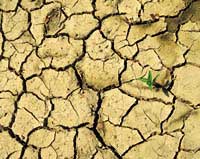water crisis
-
Quench Warners
Desalination won’t solve world’s water woes, report says Another high-tech environmental solution may be going out the window: a new report from the World Wildlife Fund says desalinating water could hurt more than it helps. Estimating that there are more than 10,000 desalination plants around the world, WWF says the energy-intensive practice of filtering salt […]
-
Declining production and what comes next
This week the Durango Herald discussed the steadily declining production of methane gas from wells in southern Colorado's La Plata County and what impacts there will be when the wells go dry.
Unfortunately, the article focuses only on the economic implications and goes nowhere on the topic of what the landscape will look like when those companies pull up stakes for new pastures. Even if all the well pads are reclaimed, which would be a miracle, what kind of rangeland and habitat will these parts of the West be left with when the boom is over?
-
Company presentation offers glimpse of life on the other side
Have you ever wanted to be a fly on the wall at a top-level corporate meeting just to see what really goes on behind closed doors? Consider this nifty PowerPoint presentation your ticket in.
It turns out chlorine companies talk about Oceana in their meetings as much as Oceana talks about them. The Chlorine Institute held a meeting a few months back where one of the companies gave a formal presentation about being "In the 'Crosshairs' of an Environmental NGO."
Their presentation looks an awful lot like our presentations -- outlining all of our tactics to stop seafood contamination, which to them are challenges they need to overcome. It's nice to know that ERCO has realized Oceana's in it for the long haul.
My favorite slide? "Essential survival tactics."
-
The two don’t mix well
This story deserves singling out because it is on an important but too-neglected subject -- the connection between energy and water.
-
Material intensity in water use
(Part of the No Sweat Solutions series.)
Before discussing water savings, we need to define what we mean by "use." The EPA refers to withdrawal and consumption. Withdrawal is the amount taken from surface water and the water table. Consumption refers to the amount chemically combined with something (so that it is no longer fresh water) or evaporated. Water discarded instead of consumed is referred to as "returns," because it is supposedly reusable. This does not even approximate the impact of water use.
One example the EPA gives is power plant cooling. The water is withdrawn and used to cool the plant. A little evaporates, and the rest returned (still more or less clean) to the source. This overlooks a certain amount of impact (fish killed during withdrawals, aquatic plant, fungal, and microbial growth encouraged by the change in water temperature), but is basically correct. However, they apply the same logic to water used for irrigation. With very few exceptions, irrigation water "returns" are loaded with fertilizer salts, growth hormones, microbes, and often pesticides and herbicides as well. Even runoff from organic farms usually contains salts from the manure and composts used.
So the proper way to count water is consumption plus polluted returns -- in most cases, all withdrawals.
-
How high and how fast?
How high and fast will sea levels rise? An important piece (PDF) by Stefan Rahmstorf in Science concludes:
A rise of over 1 m by 2100 for strong warming scenarios cannot be ruled out, because all that such a rise would require is that the linear relation of the rate of sea-level rise and temperature, which was found to be valid in the 20th century, remains valid in the 21st century.
-
The world is running low on H2O
Droughts in the United States, Ethiopia, and Afghanistan have been big news this year — and even more serious water shortages are emerging as the demand for water in many areas of the world simply outruns the supply. Water tables are now falling on every continent. Literally scores of countries are facing water shortages. All […]
-
Three
• factor by which an average resident of an industrialized nation consumes more fresh water than an average resident of a developing nation • factor by which sulfur dioxide emissions are expected to increase in Asia by 2010 • number of hours a television can be powered with the energy saved from a recycled aluminum […]
